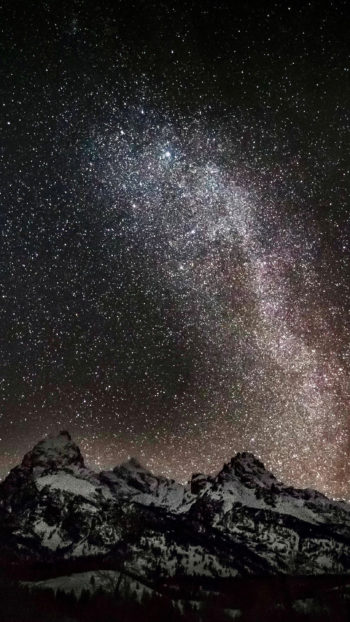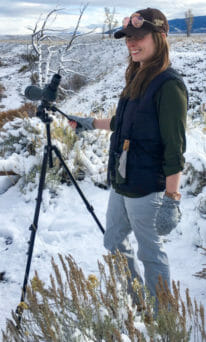Grand Teton National Park is known for its towering peaks, charismatic wildlife, and breathtaking landscapes. So why visit Grand Teton at night? When the sun sets, it transforms into one of the best stargazing destinations in the United States. With minimal light pollution, high elevations, and vast open skies, this national park offers an unparalleled view of the cosmos. Whether you’re hoping to see the Milky Way stretch across the horizon, witness a meteor shower, or gaze at distant galaxies, this guide will help you discover why Grand Teton stargazing tours are a bucket list experience—and how you can make the most of your visit.
Stargazing in Grand Teton National Park is a bucket list experience for anyone who appreciates the beauty of the night sky. The park’s combination of dark skies, breathtaking landscapes, and unique natural features creates a truly magical stargazing environment. Here, we’ll explore why it should be on every stargazer’s list.
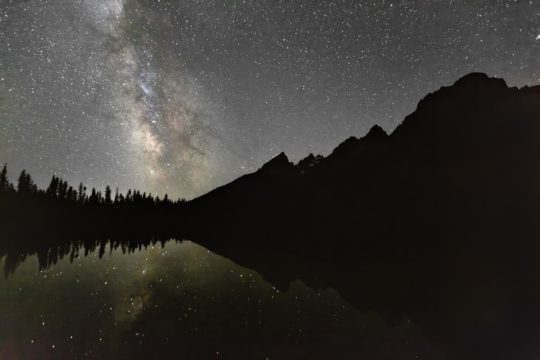

What Makes Grand Teton National Park a Dark-Sky Haven?
Grand Teton National Park is a dark-sky haven for stargazers due to its combination of minimal light pollution, remote location, high elevation, and dedicated conservation efforts.
Minimal Light Pollution for Pristine Night Sky Views
One of the key factors that makes Grand Teton National Park a dark-sky haven is its low levels of light pollution. Teton County, which is home to both the park and to its nearest urban neighbors, is certified as an International Dark Sky Community. This means that special attention has been given throughout the county to limit artificial lighting and light pollution; because of this, the night sky remains dark and pristine. Grand Teton itself is working toward becoming an International Dark Sky Park, a title awarded to locations that actively reduce light pollution and protect the natural night environment, making it the ideal spot for Wyoming astronomy tours.
High Elevation Enhances Star Visibility
With elevations ranging from 6,000 feet to over 13,000 feet at the top of the Grand Teton, the park offers a high vantage point for stargazing. The thinner air at these higher elevations results in clearer skies, as there’s less atmospheric distortion from haze, moisture, or pollution. This means that stargazers can enjoy sharper, more vivid views of distant stars, galaxies, and other celestial phenomena.
Protected Lands Ensure Unobstructed Celestial Views
Local conservation groups and the park’s management team have made dedicated efforts to preserve the area’s dark skies. This includes controlling artificial light from street lamps, buildings, and outdoor lighting around the park. The park’s Dark Sky Initiative encourages the use of shielded lighting, motion sensors, and warm LED bulbs to minimize light spill. These efforts help keep the integrity of our dark sky areas in Wyoming and preserve the natural beauty of the night.
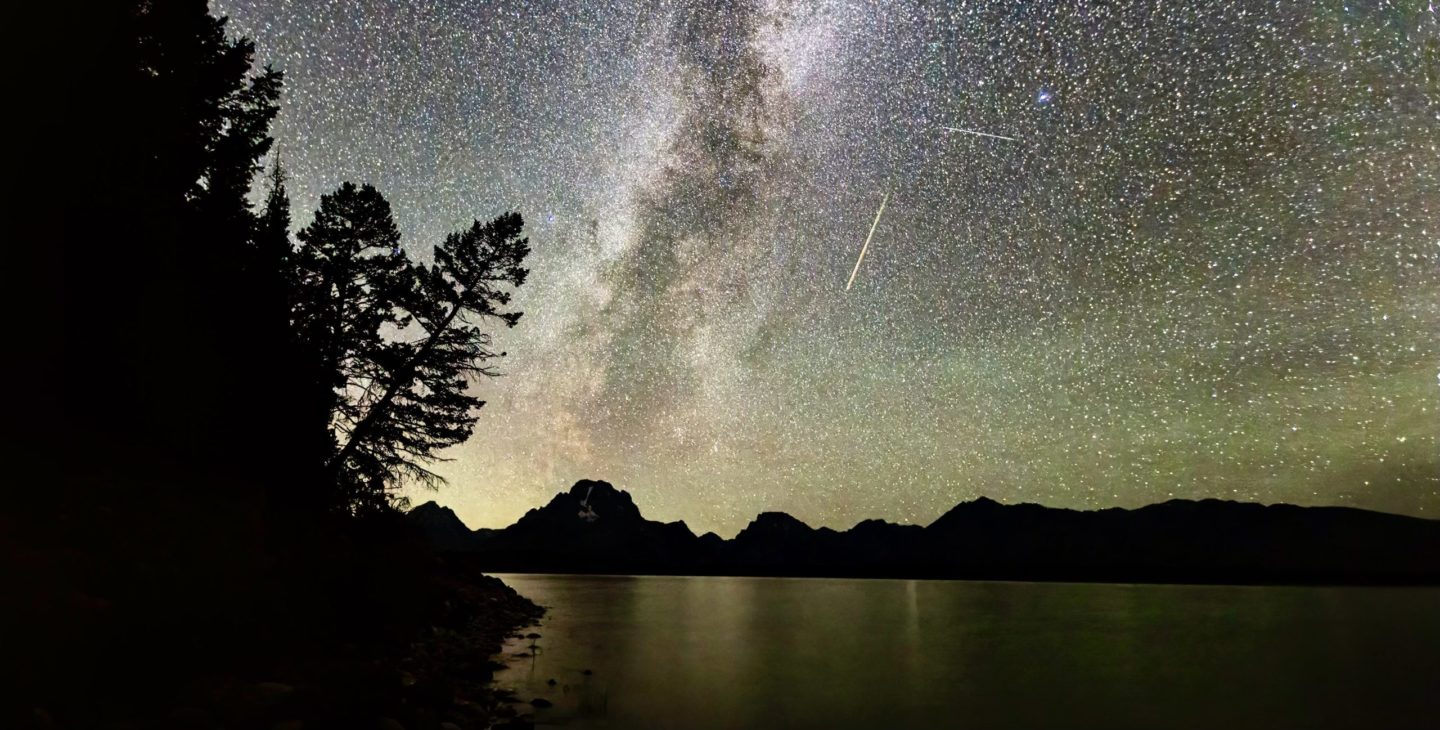
Best Locations for Stargazing in the Tetons
Grand Teton National Park offers some of the most stunning stargazing opportunities in the U.S., thanks to its remote location, high elevation, and minimal light pollution. Whether you’re a seasoned astronomer or a first-time stargazer, these are the best stargazing spots in Grand Teton National Park to take in the night sky:
Jenny Lake – Stunning Reflections and Open Horizons
Jenny Lake is a popular spot for stargazing due to its clear views of the Teton peaks and the reflective water that mirrors the stars. The area around South Jenny Lake or North Jenny Lake provides quiet and accessible locations with a stunning backdrop, perfect for a night under the stars.
Signal Mountain – Elevated Views Away from Crowds
For those looking to stargaze from a higher elevation without extensive hiking, the Signal Mountain Summit provides panoramic views of Jackson Hole, the Snake River, and the Teton Range. This easily accessible summit (via the Signal Mountain Summit Road) offers excellent views of the night sky and is a great spot for catching a celestial event or simply taking in the stars.
Mormon Row – Historic Setting with Expansive Skies
Located in the Antelope Flats area, Mormon Row is famous for its historic barns and stunning views of the Teton Range. This quiet, rural setting is perfect for capturing the Milky Way with the iconic barns in the foreground. The lack of light pollution makes it a peaceful and picturesque spot for stargazing.
Jackson Lake – Perfect for Astrophotography
The calm, reflective waters of Jackson Lake provide a unique opportunity to capture stunning, mirrored images of the night sky. The Teton Range serves as a dramatic backdrop, with the stars, Milky Way, and even meteors reflecting beautifully in the water, creating double exposures that are perfect for photography.

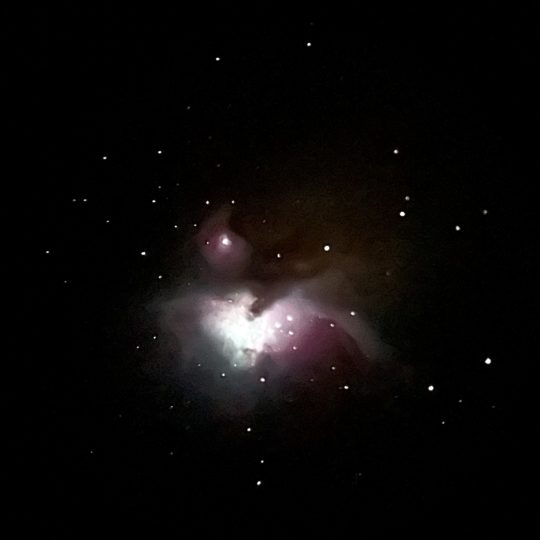
What You Can See in Grand Teton’s Night Sky Throughout the Year
Grand Teton National Park, located in Wyoming, is an amazing place for stargazing, thanks to its remote location, low light pollution, and stunning mountain views. The night sky changes with the seasons, offering different celestial wonders throughout the year. Here’s a glimpse of what you can expect to see over the course of the year:
Summer – The Milky Way in Its Full Glory
June to August is prime time for stargazing in Grand Teton, with the Milky Way in full view. The galactic core stretches across the sky, and summer constellations like Hercules, with its Great Globular Cluster, shine brightly. The Summer Triangle, an asterism made up of the bright stars Vega, Deneb, and Altair, provides an easy-to-spot guide for navigating the summer sky. The Perseid meteor shower in August is one of the highlights of the season, often offering a stunning display of meteors streaking across the dark, high-altitude sky.
Fall – Peak Meteor Shower Season
September to November brings a mix of fading summer constellations and new ones emerging in the cooler air. The Great Square of Pegasus becomes prominent, with the nearby Andromeda galaxy visible to the naked eye under the right conditions. As the autumnal equinox passes, equal day and night lengths provide a nice balance for celestial observations. Constellations like Cassiopeia, with its distinctive “W” shape, become more prominent in the northern sky. The Orionid meteor shower, which peaks in mid-October, provides another chance to witness meteors, as it’s associated with the debris of Halley’s Comet.
Winter – Crystal-Clear Views and Possible Aurora Borealis
December to February in Grand Teton brings some of the clearest skies of the year, making it an ideal time for stargazing. The constellation Orion is prominent, with its distinct “belt” easily visible in the night sky. Nearby, the Pleiades star cluster, also known as the “Seven Sisters,” shines brightly, while Gemini and its twin stars, Castor and Pollux, are also visible. Although the Milky Way isn’t as prominent during winter, you can still catch parts of it stretching across the sky, especially in darker, more remote areas of the park.
Spring – Prime Time for Viewing Galaxies and Star Clusters
March to May offers a shift in the constellations visible in the night sky. Virgo and Leo rise, bringing with them the bright star Regulus, which marks the heart of the lion in Leo. As the nights grow longer and warmer, galaxies and star clusters come into view, including Bode’s Galaxy in Ursa Major and the Great Globular Cluster in Hercules. The Milky Way also begins to reappear, especially the galactic core, which can be seen low in the southern sky. Spring also brings the Lyrid meteor shower in mid-April, a minor but beautiful shower for those willing to brave the cool evenings.
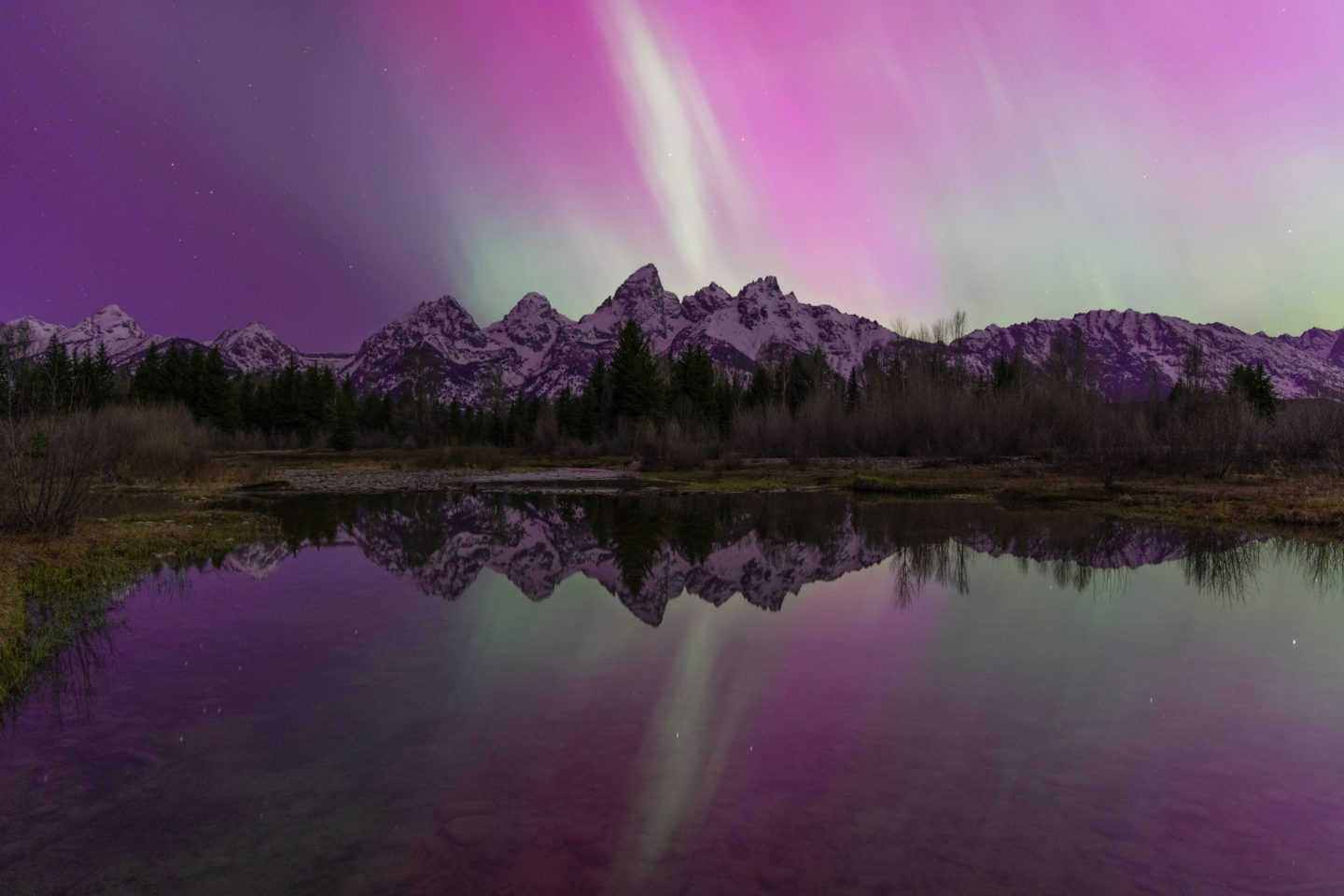
Guided Stargazing vs. Self-Guided: Which is Best?
Stargazing is an activity that is accessible to anyone who is willing to go to the right place at the right time. Anyone can do it, however self-guided stargazing will be a vastly different experience than with an expert guide. Here are some of the things to keep in mind when deciding:
Benefits of a Guided Stargazing Tour with Experts
A knowledgeable guide can explain the history and mythology behind constellations, share fascinating facts about celestial objects, and give you insights into the science of the universe that you may not discover on your own. Your guide will provide equipment such as high-powered telescopes, binoculars, and other gear that might be difficult or expensive for you to bring along. This lets you see far more detail, such as distant galaxies or the rings of Saturn. Guided tours are usually well-planned, meaning you’ll see the best parts of the sky at the right time, especially if there’s an astronomical event like a meteor shower or eclipse.
What to Expect on a Professional-Led Tour
A professional-led stargazing tour offers an informative and enjoyable way to explore the night sky. You’ll learn about constellations, planets, and celestial phenomena while using high-quality telescopes and equipment to view distant stars and galaxies in detail. The tour takes place in optimal locations, away from light pollution, and often includes insights into current celestial events. It’s a relaxed, social experience where you can ask questions, interact with others, and soak in the beauty of the universe, all while being guided through the night sky with expert knowledge. Additionally, if you’re interested in the local wildlife as well as taking in the starry night, you can choose a combination sunset safari & stargazing tour to get the best of both worlds.
Tips for Self-Guided Stargazing Adventures
Self-guided stargazing is for those who want more independence and control over their stargazing experience. Whether you’re using a stargazing app, a star chart, or just your eyes, self-guided stargazing allows you to explore the night sky on your own terms. Wear warm layers as the evenings get cold, and sturdy shoes. Bring a chair or blanket to sit on while you gaze up. If you have binoculars or a telescope, be sure to bring them along. A flashlight with a red filter will help you to see without compromising your ability to see the stars.
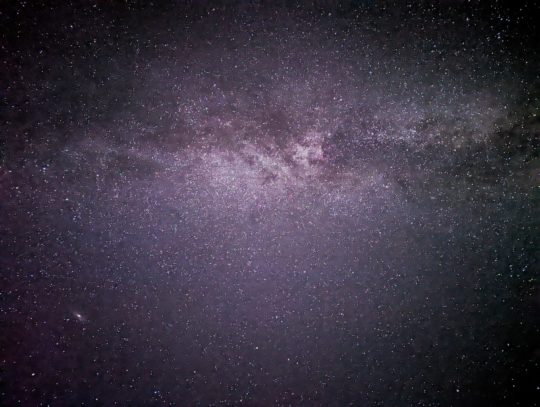
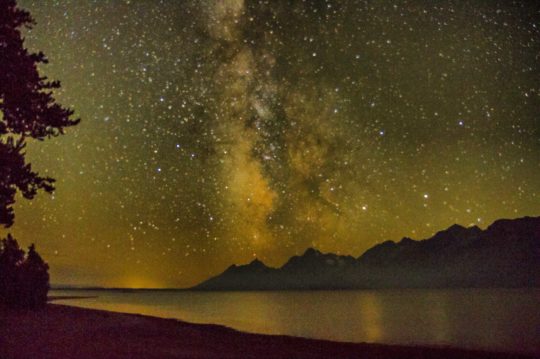
How to Make the Most of Your Grand Teton Stargazing Tour
To make the most of your Grand Teton stargazing tour, preparation and mindset are key. Here are some tips to ensure you have an unforgettable experience
Best Times to Go for Optimal Night Sky Viewing
While seasons and moon phases are important, always keep an eye on the weather forecast. Clear, dry nights with low humidity provide the best visibility for stargazing. Cloud cover, storms, or fog can quickly ruin a stargazing session, so aim for nights with forecasted clear skies. Grand Teton’s altitude and remote location help ensure that on clear nights, the sky will be pristine and unpolluted by artificial light. The new moon phase is when the moon is not visible in the sky, allowing the darkest, clearest skies for stargazing. During this time, you’ll be able to see fainter objects like nebulae, distant galaxies, and even the Milky Way’s core in its full glory. Check the lunar calendar before planning your trip to align with a new moon phase, as this will offer the best stargazing conditions.
Essential Gear to Bring for Stargazing Success
Grand Teton’s high-altitude environment means temperatures can drop significantly at night, even in the summer. Wear layers—thermal clothing, a warm jacket, gloves, and a hat—to stay comfortable. Bring a blanket or a folding chair for sitting and staying cozy while you observe the stars. If you’re interested in photography and own a camera, make sure you bring it along! Grand Teton night sky photography is unlike any other. A tripod is essential for astrophotography, so don’t forget to pack one.
How to Enhance Your Experience with Star Apps and Telescopes
Apps like SkyView and Stellarium allow you to point your phone at the sky to instantly identify stars, constellations, and planets. This can help you familiarize yourself with the celestial objects you’re observing. They also show you the path of constellations over time, so you can follow the changing sky throughout the night. Using a telescope adds a whole new layer of depth to your stargazing experience, allowing you to see the intricate details of celestial objects that you can’t catch with the naked eye. Many telescopes also come with smartphone mounts, allowing you to align your phone with the telescope’s eyepiece, making it easier to spot objects in the sky.
Whether it is your first time stargazing or you are an enthusiast, don’t miss the opportunity to experience our guided stargazing in Jackson Hole. With towering mountains, deep, dark skies, and wide open wild spaces, it is a stargazer’s paradise.
FAQs
Why is Grand Teton National Park one of the best places for stargazing?
Grand Teton National Park is part of Teton County, a designated dark-sky location, meaning it has minimal light pollution, making celestial objects appear brighter and more detailed. The park’s high elevation and dry climate further enhance visibility, offering crisp, clear views of the Milky Way, constellations, and even deep-space objects.
What is the best time of year to stargaze in Grand Teton National Park?
Summer offers the best chance to see the Milky Way in its brightest form, while fall and winter provide exceptionally clear skies with fewer visitors. If you want to catch meteor showers, the Perseids in August and the Geminids in December are spectacular.
Do I need a permit to stargaze in Grand Teton National Park?
No, you do not need a permit for general stargazing. However, if you plan to camp overnight or use specific equipment like telescopes in designated areas, you may need to check park regulations to ensure compliance with nighttime access rules.
Should I take a guided stargazing tour or go on my own?
A guided stargazing tour offers the best experience, as expert guides provide high-powered telescopes, in-depth knowledge of celestial objects, and access to the best viewing locations. If you prefer a self-guided adventure, plan ahead by researching dark-sky locations and moon phases for optimal visibility.
What should I bring for a stargazing trip in Grand Teton National Park?
Essentials include warm clothing, a red flashlight (to preserve night vision), binoculars or a telescope, and a star map or stargazing app. If you’re taking photos, bring a tripod and a camera with long exposure settings for capturing stunning night sky images.



